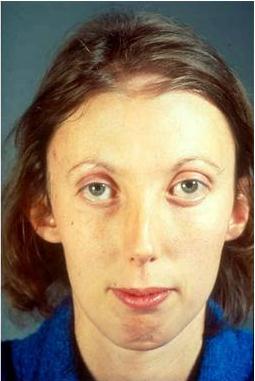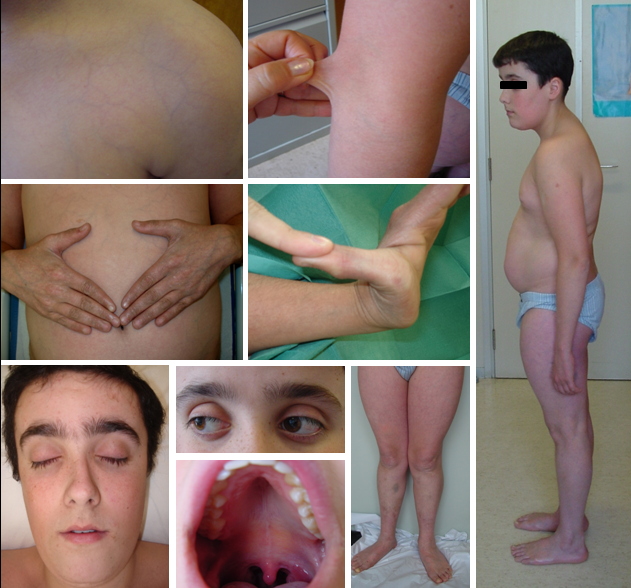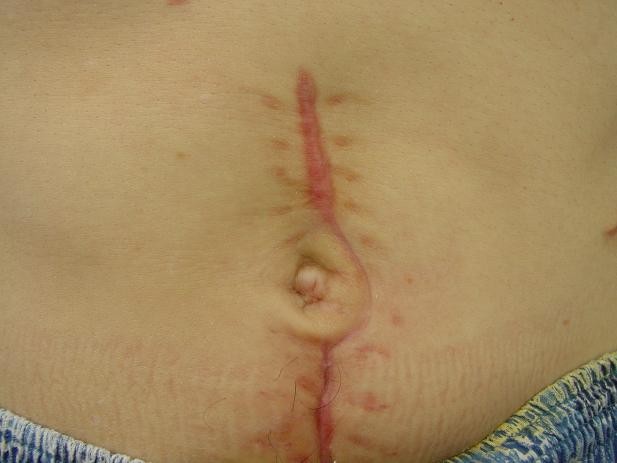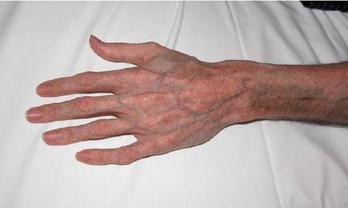Vascular Ehlers-Danlos Syndrome (vEDS)
The Ehlers-Danlos syndromes (EDS) are a group of 13 related conditions that affect connective tissue (1). Connective tissue is found everywhere in the body. It connects other types of tissues, separates them, and supports them. Examples of connective tissue include bone, cartilage, fat, blood, and lymphatic tissue. When connective tissue is abnormal because of a disease, a variety of problems result.
For example, certain problems happen in all of forms of EDS. The first is joint hypermobility (often called loose or double joints). People with EDS can often move their joints in ways that are impossible for most unaffected people. The photograph at the bottom of this page has an example (note that many people without EDS have loose joints, so having joint hypermobility does not mean that you have EDS). The second thing that happens in every type of EDS is stretchy (hyperextensible) skin. This feature is nearly universal in some types of EDS (such as type 1, the classical form). In our literature survey, we found that stretchy skin occured in less than half of people with the hypermobile and vascular forms, more than half of patients with the periodontitis type, and in a large majority of people with the arthrochalasia type (>80%).
Many forms of EDS happen because of mutations in genes that make collagen, which can be thought of as both holding the body together and strengthening it. Collagen gives structure to muscles, tendons, skin and bones. In most people, it is abundant in these tissues. In people with EDS, collagen may not be as strong as it should be, or there may not be enough of it. For example, skin and joints may be loose because they don't have enough collagen to hold them together securely, or because the collagen they have is weaker than it should be.
Doctors and other medical professionals assess joint hypermobility with a scoring system called the Beighton score, which was developed in the early 1970s (2). This simple system scores your ability to move a joint past certain angles. The highest score is 9 points, and higher scores mean greater joint hypermobility. Generally speaking, scores of 4 or higher (at any time, past or present) indicate joint hypermobility. Many EDS patients have scores of 8 or 9, although many have lower scores, and a minority do not have hypermobile joints. Interested readers may wish to see a basic description of the scale with a video and photos or a more technical description.
Joint hypermobility puts EDS patients at high risk for joint dislocations and partial dislocations (called subluxations). These problems can be painful, and in some cases, debilitating. Surgical procedures have been used to improve skeletal stability and improve quality of life; for examples and reviews, see references 3-5. However, experts tend to agree that non-surgical options should always be exhausted first, and careful discussions with doctors are important in this decision.
Tissue fragility is another common feature of EDS. This problem is very serious in the vascular type of EDS (vEDS). The type of collagen affected in vEDS plays a role in supporting blood vessels. When the integrity of their support system is affected, blood vessels can rupture spontaneously. This problem is especially dangerous because it affects medium and large blood vessels, as well as small ones. It also affects the bowel. Surgery on a person with vEDS must be performed with great care in order to avoid serious complications. This problem may also happen in kyphoscoliotic EDS (kEDS), but it is less common than in vEDS. Alternatively, while people with the hypermobile form (hEDS) are also prone to blood vessel ruptures, ruptures tend to occur in the small blood vessels. Tissue fragility can also lead to hernias and problems in pregnancy. Fragile skin is also a common manifestation of EDS, especially in people with the classic, kyphoscoliotic, and periodontitis types.
Tissue fragility in EDS can also lead to hernias and problems in pregnancy. Fragile skin is also a common manifestation of EDS, especially in people with the classic, kyphoscoliotic, and periodontitis types.
A new classification system for EDS was released in 2017 (1). It's called the 2017 International Classfication for the Ehlers-Danlos Syndromes. This new system names 13 different subtypes of EDS. It relies primarily on descriptive terms for different types of EDS (e.g. vascular EDS, meaning that it affects blood vessels prominently). Two other systems existed before this one. They were named Villefanche [1998] and Berlin [1988]. Both systems used names and numbers. The numbers in the new system are different from the old ones, and we've included the old ones here. Advances in genetics have allowed to researchers to find genes that cause different subtypes of EDS, which has allowed them to separate the old classic subtype (numbered 1 & 2) of EDS into 2 different subtypes.
- 1. Classical EDS (cEDS; formerly type 1/2)
- 2. Classical-like EDS (cEDS; formerly type 1/2)
- 3. Cardiac-valvular (cvEDS)
- 4. Vascular (vEDS)
- 5. Hypermobile (hEDS; formerly type 3)
- 6. Arthrochalasia (aEDS; formerly type 7a/b)
- 7. Dermatosparaxis (dEDS; formerly type 7c)
- 8. Kyphoscoliotic (kEDS; formerly type 6)
- 9. Brittle Cornea syndrome (BCS)
- 10. Spondylodysplastic (spEDS)
- 11. Musculocontractural (mcEDS)1
- 12. Myopathic (mEDS); type 12
- 13. Periodontal (pEDS; formerly type 8)
EDS affects women more commonly than men. In the literature survey we did for our analytics tool, we counted the number of male and female patients while we were characterizing in six different types of EDS. Altogether, we analyzed data from ~1,200 patients. Sex information was available for ~1,100. The table below shows that although more EDS patients are women in each type of EDS, the female:male ratio varied between each type. For example, females dominated the individuals reported with the hypermobility type, while males comprised a substantial minority of kyphoscoliotic and arthrochalasia patients. The distribution was roughly even in the periodontal type. However, the low number of case reports for these three types of EDS may have affected the outcome of this small analysis.
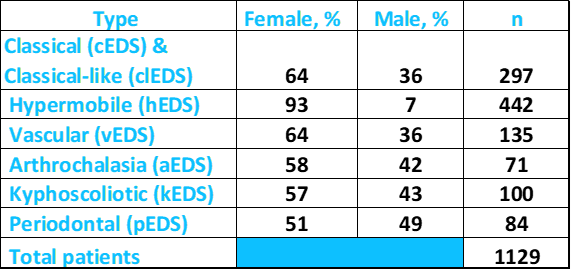
Above: Percentages of male and female patients with different types of EDS. Source: FDRF via published literature.
According to NIH's Genetics Home Reference (see link at right), the prevalence of all forms of EDS is roughly 1 in 5,000 worldwide. The kyphoscoliotic type (kEDS) is very rare, and although exact figures are not known, the GeneReviews article at the right estimates that it occurs in one birth per 100,000.
Clinical information
vEDS is a severe form of EDS. Its most important feature is fragility of the blood vessels, intestines, and/or the uterus. Because the disease is often not diagnosed in a timely manner, it may go undiagnosed until after death. Otherwise, it may only be recognized when a person presents with gastrointestinal perforations, organ ruptures, or ruptured blood vessels. In some undiagnosed patients, these problems can occur during surgery, resulting in fatalities. For this reason, any surgery on a person with vEDS should be carefully planned, in consulation with clinicians who are knowledgeable about the disease. Patients also have a tendency to prolonged bleeding, in spite of no coagulation abnormalities (6). Bleeding may result from activities as benign as brushing teeth. This problem, in combination with increased tissue fragility, can also create complications during surgery. Surgeons may be unable to suture internal tissues, resulting in blood loss that may be fatal.
vEDS patients also have a tendency for prolonged bleeding, in spite of not having coagulation abnormalities (6). Bleeding may result from activities as ordinary as brushing teeth. This problem, in combination with increased tissue fragility, can also create complications during surgery. Surgeons may be unable to suture internal tissues, resulting in blood loss that may be fatal.
Vascular ruptures/dissections and organ ruptures are serious problems in vEDS. They may occur spontaneously, and vascular ruptures may occur after aneurysms and other problems. Beighton (7) described a case of a 7-year-old boy with EDS4. While sitting in school, he suffered sudden pain due to peritonitis that was secondary to perforation of the colon. His colon ruptured again when he was 10, and he died at 14 of sudden tearing in large arteries. He was also described as being prone to skin lacerations "at the slightest provocation." Because of the possibility of these types of problems, people with vEDS are encouraged to seek medical attention immediately if they experience sudden, unexplained pain.
In addition, periodic monitoring with non-invasive scanning equipment is critically important in this condition. A review on vEDS states that arterial ruptures and dissections (tears in the lining of an artery) are both unpredictable and the cause of a majority of deaths in vEDS (8). The fragility of the blood vessels makes them difficult to repair surgically. These problems tend to occur in large- and medium-sized arteries (8), with the following are often involved:
- Proximal branches of the aorta
- Descending thoracic aorta
- Renal, mesenteric, iliac, or femoral arteries
In addition, pregnant women with vEDS should be monitored carefully, as complications, including mortality due to rupture of the uterus, are increased over the general population (9).
Joint hypermobility in vEDS patients tends to occur mainly in the small joints, and the skin is not as stretchy/hyperextensible as it is in patients with other forms of EDS (see photos below). Patients may also have acrogeria, which is a prematurely aged appearance of the extremities (see photo below).
Some patients with vEDS have a distinctive facial appearance (see photos at top right and below). These feature include large eyes, thin lips, a thin or pinched nose, blue sclera, and underdeveloped earlobes. Otherwise, the most common signs and symptoms of this condition are as follows:
- Fragile blood vessels that are prone to rupturing
- Aneurysms or false aneurysms
- Fragile skin that may lacerate after very minor trauma
- Wounds that heal poorly after injury or stitching/suturing
- Scars that may be deeply pigmented
- Acrogeria (premature aging of the extremities; see photo below)
- Easy bruising (may occur without injury/trauma)
- Mildly stretchy skin that appears normal after being released
- Joint hypermobility of the small joints
- Flat feet
Signs and symptoms of vascular EDS
Diagnosis and Testing
vEDS is an autosomal dominant disorder. This term means that it can be passed from one affected parent to a child. This mode of transmission occurs in roughly half of patients. In the others, the mutation arises spontaneously in families without an affected parent. Mutations in a gene called type 3 collagen (COL3A1) are the most common causes of vEDS. Mutations in type 1 collagen (COL1A1) may also cause it, though rarely (1). The link at the right provides information about labs that test for mutations in EDS.
It's important to remember that features of the different forms of EDS overlap. As a result, without laboratory testing, accurate subcategorization of EDS in a patient may be difficult or even impossible. This fact makes testing important; it is especially so in the case of vEDS, which involves so many potentially fatal complications.
Differential Diagnosis
The differential diagnosis for vascular EDS includes the other forms of EDS. In particular, clinical findings in in vEDS overlap with those of the classic and classic-like form of EDS (formerly type 1/2). Most classic EDS patients have mutations in the genes COL5A1 or COL5A2, which encode type 5 collagen, although COL1A2 is mutated in a minority of cases. Clinicians may also wish to test for the kyphoscoliotic form of EDS.
Overall, joint hypermobility occurs in a variety of medical conditions, and many people without a medical condition have lax joints. In fact, when not part of a disorder, hypermobile joints confer an advantage in sports such as gymnastics and ice skating, as well as in certain forms of dance.
Marfan syndrome. Most medical conditions involvong lax joints are relatively easy to distinguish from EDS, but some are not. Marfan syndrome is an example. Like EDS, Marfan syndrome is a connective tissue disorder and patients have lax joints. Marfan patients generally have a body type called a Marfanoid body habitus. This term means that a person is tall and slender, with long arms, hands, fingers, legs, feet and toes. A Marfanoid body habitus occurs in a minority of hypermobile EDS patients, and it doesn't appear to be generally associated with classic EDS. The Marfan Foundation has many photographs of Marfan patients of different ethnicities. Unlike EDS patients, Marfan patients do not appear to have fragile skin and blood vessels.
Cutis laxa. Superficially, the stretchy skin found in most forms of EDS may be confused with cutis laxa type 1 and type 2, as stretchy skin is also a feature of these conditions. However, the skin in cutis laxa patients tends to sag and does not return to its normal position after being extended. Cutis Laxa patients often have a prematurely aged appearance.
The Gene Review on vascular EDS (see link at right) has a list of other conditions that are part of the differential diagnosis for EDS. They include Loeys-Dietz syndrome, Stickler syndrome, and a number of others. In addition, Because they bruise so easily and experience joint dislocations and subluxations, very young vEDS patients may be suspected of child abuse.
References
- 1. Malfait F et al. (2017) The 2017 International Classification of the Ehlers-Danlos Syndromes Am J Med Genet C 175(1):8-26. Abstract on PubMed.
- 2. Beighton P et al. (1973) Articular mobility in an African population. Ann Rheum Dis 32(5):413-418. Full text on PubMed.
- 3. Cole AS et al. (2000) Recurrent instability of the elbow in the Ehlers-Danlos syndrome. A report of three cases and a new technique of surgical stabilisation. J Bone Joint Surg Br 82(5):702-704. Full text from publisher.
- 4. Weinberg J et al. (1999) Joint surgery in Ehlers-Danlos patients: results of a survey. Am J Orthop 28(7):406-409. Abstract on PubMed.
- 5. Shirley ED et al. (2012) Ehlers-Danlos syndrome in orthopaedics. Etiology, diagnosis, and treatment implications. Sports Health 4(5):394-403. Full text on PubMed.
- 6. Barabas AP (1972) Vascular complications in the Ehlers-Danlos syndrome, with special reference to the "arterial type" or Sack's syndrome. J Cardiovasc Surg (Torino) 13:160-167. Abstract on PubMed.
- 7. Beighton P (1993) The Ehlers-Danlos syndromes. McKusick's Heritable Disorders of Connective Tissue (5th edition; ed. Peter Beighton); Mosby, St. Louis, Chapter 6; pages 216-217.
- 8. Germain DP (2007) Ehlers-Danlos syndrome type IV. Orphanet J Rare Dis 2:32. Full text on PubMed.
- 9. Murray ML et al. (2014) Pregnancy-related deaths and complications in women with vascular Ehlers-Danlos syndrome. Genet Med 16(12):874-880. Full text from publisher.
- 10. Vanakker OM et al. (2011) Hereditary Connective Tissue Diseases in Young Adult Stroke: A Comprehensive Synthesis. Stroke Res Treat Volume 2011Article ID 712903 Full text on PubMed.
- 11. Kashizaki F et al. (2013) Vascular-type Ehlers-Danlos syndrome caused by a hitherto unknown genetic mutation: a case report. J Med Case Rep 735. Full text on PubMed.
- 12. Morais P et al. (2011) Vascular Ehlers-Danlos syndrome : A case with fatal outcome. Derm Online J 17(4):1. Full text from publisher.
